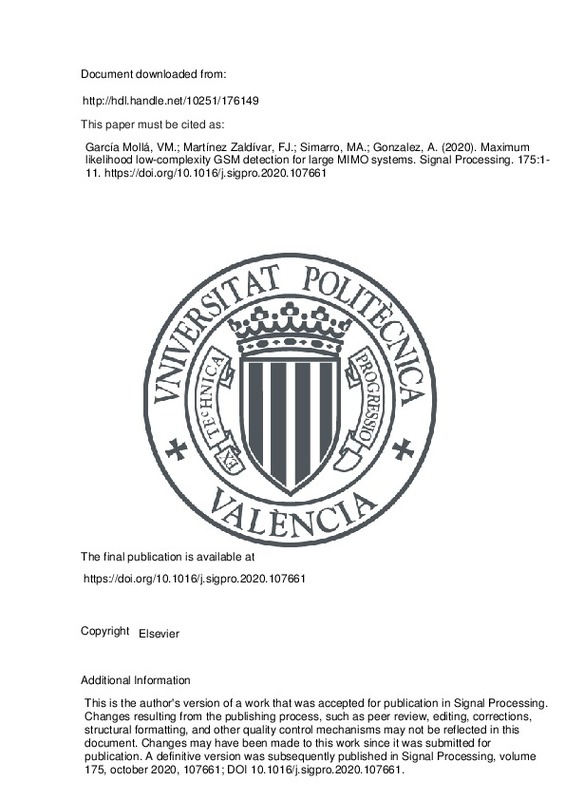García Mollá, VM.; Martínez Zaldívar, FJ.; Simarro, MA.; Gonzalez, A. (2020). Maximum likelihood low-complexity GSM detection for large MIMO systems. Signal Processing. 175:1-11. https://doi.org/10.1016/j.sigpro.2020.107661
Por favor, use este identificador para citar o enlazar este ítem: http://hdl.handle.net/10251/176149
|
Título:
|
Maximum likelihood low-complexity GSM detection for large MIMO systems
|
|
Autor:
|

 García Mollá, Víctor Manuel
García Mollá, Víctor Manuel

 Martínez Zaldívar, Francisco José
Martínez Zaldívar, Francisco José
 Simarro, M. Angeles
Simarro, M. Angeles

 Gonzalez, Alberto
Gonzalez, Alberto
|
|
Entidad UPV:
|
Universitat Politècnica de València. Departamento de Comunicaciones - Departament de Comunicacions
Universitat Politècnica de València. Departamento de Sistemas Informáticos y Computación - Departament de Sistemes Informàtics i Computació
Universitat Politècnica de València. Instituto Universitario de Telecomunicación y Aplicaciones Multimedia - Institut Universitari de Telecomunicacions i Aplicacions Multimèdia
|
|
Fecha difusión:
|
|
|
Resumen:
|
[EN] Hard-Output Maximum Likelihood (ML) detection for Generalized Spatial Modulation (GSM) systems involves obtaining the ML solution of a number of different MIMO subproblems, with as many possible antenna configurations ...[+]
[EN] Hard-Output Maximum Likelihood (ML) detection for Generalized Spatial Modulation (GSM) systems involves obtaining the ML solution of a number of different MIMO subproblems, with as many possible antenna configurations as subproblems. Obtaining the ML solution of all of the subproblems has a large computational complexity, especially for large GSM MIMO systems. In this paper, we present two techniques for reducing the computational complexity of GSM ML detection.
The first technique is based on computing a box optimization bound for each subproblem. This, together with sequential processing of the subproblems, allows fast discarding of many of these subproblems. The second technique is to use a Sphere Detector that is based on box optimization for the solution of the subproblems. This Sphere Detector reduces the number of partial solutions explored in each subproblem. The experiments show that these techniques are very effective in reducing the computational complexity in large MIMO setups.
[-]
|
|
Palabras clave:
|
MIMO
,
Signal detection
,
Maximum likelihood detection
,
GSM
|
|
Derechos de uso:
|
Reconocimiento - No comercial - Sin obra derivada (by-nc-nd)
|
|
Fuente:
|
Signal Processing. (issn:
0165-1684
)
|
|
DOI:
|
10.1016/j.sigpro.2020.107661
|
|
Editorial:
|
Elsevier
|
|
Versión del editor:
|
https://doi.org/10.1016/j.sigpro.2020.107661
|
|
Código del Proyecto:
|
info:eu-repo/grantAgreement/AEI//RTI2018-098085-B-C41-AR//DYNAMIC ACOUSTIC NETWORKS FOR CHANGING ENVIROMENTS/
info:eu-repo/grantAgreement/GENERALITAT VALENCIANA//PROMETEO%2F2019%2F109//COMUNICACION Y COMPUTACION INTELIGENTES Y SOCIALES/
|
|
Descripción:
|
This is the author's version of a work that was accepted for publication in Signal Processing. Changes resulting from the publishing process, such as peer review, editing, corrections, structural formatting, and other quality control mechanisms may not be reflected in this document. Changes may have been made to this work since it was submitted for publication. A definitive version was subsequently published in Signal Processing, volume 175, october 2020, 107661; DOI 10.1016/j.sigpro.2020.107661.
|
|
Agradecimientos:
|
This work has been partially supported by Spanish Ministry of Science, Innovation and Universities and by European Union through grant RTI2018-098085-BC41 (MCUI/AEI/FEDER), by GVA through PROMETEO/2019/109 and by Catedra ...[+]
This work has been partially supported by Spanish Ministry of Science, Innovation and Universities and by European Union through grant RTI2018-098085-BC41 (MCUI/AEI/FEDER), by GVA through PROMETEO/2019/109 and by Catedra Telefonica-UPV through SSENCE project.
[-]
|
|
Tipo:
|
Artículo
|







![[Cerrado]](/themes/UPV/images/candado.png)


